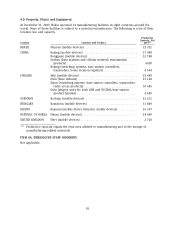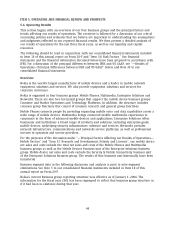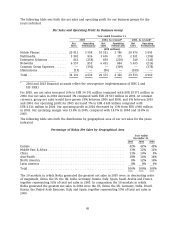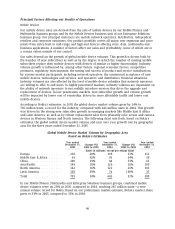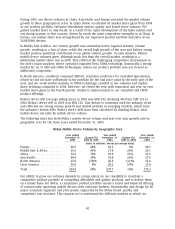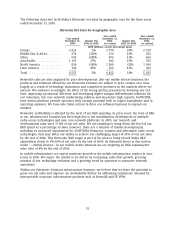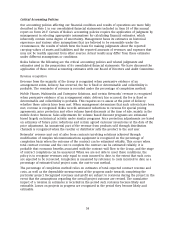Nokia 2005 Annual Report Download - page 55
Download and view the complete annual report
Please find page 55 of the 2005 Nokia annual report below. You can navigate through the pages in the report by either clicking on the pages listed below, or by using the keyword search tool below to find specific information within the annual report.average product cost, we hedge all material transaction exposures on a gross basis. All in all, the
average depreciation of the US dollar had a slightly negative impact on our operating profit in
2005. For more information, see ‘‘—Results of Operations—Exchange Rates’’ below.
Finnish Corporate Tax Rate
Effective January 1, 2005 the Finnish corporate tax rate was reduced by 3 percentage points from
29% to 26%. This reduction had a significant favorable impact on Nokia’s net profit as more than
half of Nokia’s profit before tax has been generated in Finland. See also Note 13 to our
consolidated financial statements for a further discussion of our income taxes.
Seasonality
Our device sales are somewhat affected by seasonality. Historically, the first quarter of the year
was the lowest quarter of the year, while the fourth quarter was the strongest quarter. This was
mainly due to the effect of holiday sales. The second quarter of the year was another high season,
as consumers in the Northern Hemisphere prepared for summer vacations. The third quarter was
usually slower than the second and fourth quarters, as consumers postponed purchases until the
end of year holiday season.
However, over the past four years, we have seen a trend towards less seasonality. We still
continue to see the fourth quarter as our strongest quarter, while the differences between the
three other quarters have begun to moderate. This trend has resulted, first, from the fact that the
purchasing behavior of first-time mobile device buyers tends to be more seasonal than that of
people who are replacing their device for a new model. Because replacement sales comprise an
increasing percentage of sales, the seasonality of mobile device sales has decreased. The trend
towards less seasonality has also been aided by an increase of our geographical sales reach. The
times at which people give gifts vary across the world, and as our global sales coverage increases,
this softens the seasonality of sales. However, as we still continue to see our strongest sales in the
fourth quarter, we believe that they are still supported by the year-end and holiday seasonality.
Our infrastructure business has also experienced some seasonality during the last few years. Sales
have been higher in the last quarter of the year compared with the first quarter of the following
year, due to operators’ planning, budgeting and spending cycle.
Accounting developments
As of January 1, 2005, we adopted new accounting standards, the most significant of which were:
IFRS 2, Share-based payment and IAS 39(R), Financial instruments: Recognition and Measurement,
which supersedes IAS 39 (revised 2000). These are discussed in more detail under ‘‘Basis of
presentation’’ in Note 1 and in Note 2 to our consolidated financial statements included in Item 18
of this annual report on Form 20-F.
The International Accounting Standards Board, or IASB, has and will continue to critically examine
current International Financial Reporting Standards, or IFRS, with a view toward increasing
international harmonization of accounting rules. This process of amendment and convergence of
worldwide accounting rules continued in 2005 resulting in amendments to the existing rules
effective from January 1, 2006 and additional amendments effective the following year. These are
discussed in more detail under ‘‘New IFRS standards and revised IAS standards’’ in Note 1 to our
consolidated financial statements included in Item 18 of this annual report on Form 20-F.
53


